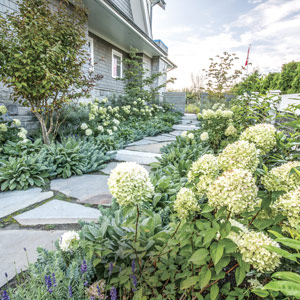The Guarding Garden
Design a gorgeous green space to protect your most precious asset
by Christina SymonsGardens and yards add beauty and tranquility to any property. But when designed and installed thoughtfully, they can also help protect and add value to your home. Read on for tips on how to make the most of your great green investment.
Sussing out the site
Reinier van de Poll knows there is more to a good garden than aesthetics. As owner of Van de Poll Garden Design, he works on landscaping and garden projects throughout the Lower Mainland, Sunshine Coast and Interior. Most homeowners come to him simply to improve their green spaces for beauty and enjoyment – however, drainage, fire safety and privacy are always part of the package.
“Clients often have a dream of using their backyard for more entertaining and as a personal retreat,” says van de Poll. “They’ll send me a wish list.”
The first step is getting to know the property. Van de Poll typically begins with a detailed review of the site, spending a few hours carefully observing and taking photos.
Homeowners should likewise take stock of their entire green space before starting any garden or landscape project. For instance: note any slopes and dips, and where existing plants are located. Are bushy trees growing too close to exterior walls? Do you have visual gaps that need filling? Is water pooling anywhere, such as on a patio or in a particular area of the lawn? Is it travelling to neighbouring properties? From there, a plan for the basic structure of the garden can take shape.

Making the grade
If your yard is uneven, it can be re-graded to create functional areas for recreation, better drainage and protection against erosion. Or, it can be stepped into tiers using retaining walls. This is what’s known as a “cut and fill” approach. It’s a cost-effective fix, says van de Poll, because it limits the amount of new soil and fill material needed and doesn’t drastically alter the layout of the yard. It also gives the homeowner a chance to create visually appealing multi-level garden zones.
One method of stabilizing soil and preventing erosion is to carefully embed boulders in sloped areas. Another is to add hardy ground cover plants. Try Vinca minor (periwinkle), Pachysandra terminalis (Japanese spurge), Fragaria chiloensis (coastal strawberry), Rubus pentalobus (emerald carpet or creeping raspberry), Hypericum calycinum (St. John’s wort) or Arctostaphylos uva-ursi (Vancouver jade or kinnikinnick).
Adequate drainage is also a high priority. “Often a large, deep [gravel-filled] pit that is hidden from sight can be a way to direct drainage from a patio space,” says van de Poll.
Creating a rain garden
Rain gardens are another practical and beautiful way to improve water management and drainage in your green space, and can be as simple as diverting a downspout into an existing garden or landscape bed. Larger and more sophisticated rain-garden beds are engineered, constructed and densely planted specifically to absorb runoff.
“Storm water is then taken up by plants or simply absorbed by the ground, just as water is absorbed by a sponge,” says Deborah Jones, longtime BC gardener and volunteer project coordinator at Cougar Creek Streamkeepers in Delta. “As that soil sponge gets saturated, excess water seeps underground to a nearby creek or other water body in a slow and steady process, continuing long after the actual rainfall – or indeed the rainy season -- has ended.” Plants that have some tolerance for both wet and dry conditions are ideal, such as acorus (sweet flag grass), native iris, bergenia and spirea.

Landscaping against fire hazards
A well-planned irrigation system will help keep lawns, plants and trees lush, healthy and free from drought stress that can raise brush-fire risk. Low-flow and drip-based irrigation systems can be installed to establish or maintain your garden on an appropriate schedule. Be sure to follow local irrigation and sprinkling bylaws. BC Fire Smart guidelines also suggest choosing only low-density, fire-resistant plants within 10 metres of any building. And regular maintenance and pruning are important for fire deterrence. “Pruning old, dead wood is important, as this type of wood is more susceptible to fire,” says van de Poll. “Keep tall bushy plants away from the house in areas of BC that are prone to drought and fires.”
Privacy, beauty and security
The old adage that fences make good neighbours need not apply in a well-planned garden. Thoughtfully placed trees and vertical hardscaping, such as arbours, pergolas and overhead post-and-beam trellises, create privacy while still maintaining the beauty of your garden. Ground-level and perimeter lighting further improve safety and security.
“The key is to distract from the unwanted view, rather than completely screen it,” says van de Poll.”
You can maintain your green privacy features in winter, too: in most of BC’s climatic zones, certain plants will retain their foliage throughout the year. “Look for camellias, heathers, Christmas roses and berried plants,” says van de Poll.
Other beauty elements to consider for your green space include water features, paths and benches. “Often a homeowner will sit on a stark patio against the back of their tall house, looking across several metres of lawn to distant plants and flowers,” says van de Poll. “A good design will place the user in the midst of the garden with plants, water features and statuary nearby – that’s garden living.”?
Photo credits: iStock, Botanica Design/Hank White Co.
Tip!
For more information on seasonal gardening and protective landscaping, visit the Master Gardeners Association of BC.
Find more great articles and useful tips on the BCAA Blog or have them sent directly to your inbox by signing up for Member Rewards emails at the bottom of the Ways to Save page, or check out the latest issue of BCAA Magazine.








